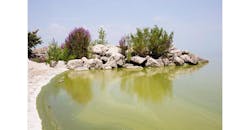The EPA on Dec. 11 proposed a new Clean Water Rule which replaces the 2015 Waters of the United States (WOTUS) rule.
“Our proposal would replace the Obama EPA’s 2015 definition with one that respects the limits of the Clean Water Act and provides states and landowners the certainty they need to manage their natural resources and grow local economies,” said EPA Acting Administrator Andrew Wheeler in a statement announcing the rule.
“For the first time, we are clearly defining the difference between federally protected waterways and state protected waterways,” added Wheller. Our simpler and clearer definition would help landowners understand whether a project on their property will require a federal permit or not, without spending thousands of dollars on engineering and legal professionals.”
The National Association of Manufacturers(NAM) applauded this change. “EPA’s new Clean Water Rule is a positive step forward for manufacturers, for our country and for responsible environmental stewardship,” said JayTimmons, CEO of NAM, who attended today’s announcement. “Manufacturers rely on clean water for everything from growing agricultural inputs to engineering green chemistry and providing renewable power.
“We simply ask for regulatory certainty,” added Timmons. The uncertainty created by the overreaching and unfair 2015 WOTUS rule threatened manufacturing jobs, and it failed to protect clean water adequately. Smart water policy is critical for all of us, and manufacturers are committed to keeping our promise to use the certainty we have been given to do our part to make our water and air cleaner—and our environment healthier. After all, the earth is the only home we have.”
Under the agencies’ proposal, traditional navigable waters, tributaries to those waters, certain ditches, certain lakes and ponds, impoundments of jurisdictional waters, and wetlands adjacent to jurisdictional waters would be federally regulated. It also details what are not “waters of the United States,” such as features that only contain water during or in response to rainfall (e.g., ephemeral features); groundwater; many ditches, including most roadside or farm ditches; prior converted cropland; stormwater control features; and waste treatment systems.
The agencies believe this proposed definition appropriately identifies waters that should be subject to regulation under the Clean Water Act while respecting the role of states and tribes in managing their own land and water resources. States and many tribes have existing regulations that apply to waters within their borders, whether or not they are considered “waters of the United States.” The agencies’ proposal gives states and tribes more flexibility in determining how best to manage their land and water resources while protecting the nation’s navigable waters as intended by Congress when it enacted the Clean Water Act.
About the Author
EHS Today Staff
EHS Today's editorial staff includes:
Dave Blanchard, Editor-in-Chief: During his career Dave has led the editorial management of many of Endeavor Business Media's best-known brands, including IndustryWeek, EHS Today, Material Handling & Logistics, Logistics Today, Supply Chain Technology News, and Business Finance. In addition, he serves as senior content director of the annual Safety Leadership Conference. With over 30 years of B2B media experience, Dave literally wrote the book on supply chain management, Supply Chain Management Best Practices (John Wiley & Sons, 2021), which has been translated into several languages and is currently in its third edition. He is a frequent speaker and moderator at major trade shows and conferences, and has won numerous awards for writing and editing. He is a voting member of the jury of the Logistics Hall of Fame, and is a graduate of Northern Illinois University.
Adrienne Selko, Senior Editor: In addition to her roles with EHS Today and the Safety Leadership Conference, Adrienne is also a senior editor at IndustryWeek and has written about many topics, with her current focus on workforce development strategies. She is also a senior editor at Material Handling & Logistics. Previously she was in corporate communications at a medical manufacturing company as well as a large regional bank. She is the author of Do I Have to Wear Garlic Around My Neck?, which made the Cleveland Plain Dealer's best sellers list.
Nicole Stempak, Managing Editor: Nicole Stempak is managing editor of EHS Today and conference content manager of the Safety Leadership Conference.
